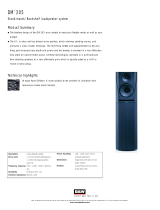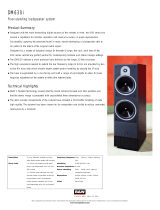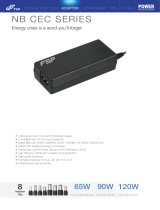2. A1 mainframe
The A1 mainframe is housed in a 3 rack unit high, 353 mm (13.9")
deep, 19" rack mount enclosure. The A1 is designed to accept a sin-
gle d&b active system controller module and includes power supplies,
separate LF and HF power amplifiers, protection circuits with their in-
dicators and a remote control interface.
All mainframe facilities and functions and those of the controller
modules can be remotely interrogated and altered via the d&b
Remote Interface Bridge (RIB).
2.1. Features
2.1.1. A1 power amplifiers
The two power amplifiers fitted to the A1 can, respectively, deliver
700 W +200 W continuous sine wave power into an 8 ohm load - in-
creasing to 1200 W + 350 W continuous sine wave power into a
4 ohms load. These output ratings are valid for at least 30 minutes of
operation at an ambient temperature not exceeding 24° C.
Continuous sine wave power rating represents an extreme of operati-
on not normally encountered when reproducing typical speech and
music signals - both complex waveforms with average power levels
usually well below their peak power level. Even when driving a d&b
active system with highly compressed music (2:1 crest factor), the A1
will operate indefinitely - provided of course that the amplifier cooling
system has sufficient cool airflow.
2.1.2. SenseDrive
The accuracy of a loudspeakers signal reproduction, both level and
transient response, is influenced by dynamic damping factor - the ra-
tio of the load to source impedance.
Especially at low frequencies, the impedance of a loudspeaker will va-
ry markedly with frequency. This impedance variation will significantly
affect the system response. Whilst amplifier source impedance remains
constant the impedance of the cables and connectors will largely de-
pend upon the length and type of cable used - longer cables produce
greater signal losses.
d&b SenseDrive compensates for the electrical properties of the loud-
speaker cable. Two sense wires connect the signal from the LF driver
back to the amplifier where it is compared and corrected to compen-
sate for the cable losses. Signal reproduction is enhanced by delive-
ring the correct signal to the loudspeaker terminals irrespective of the
cable losses.
The SenseDrive technique is not used for driving the loudspeaker HF
driver since external interference from souces such as adjacent ligh-
ting wiring could interfere with the operation of the Sense-Drive cir-
cuits. The relatively high impedance of HF drivers also tends to swamp
any increase in load impedance due to longer speaker cables.
The A1 SenseDrive circuit is gain limited and whilst this imposes a cei-
ling on damping factor improvement, it guarantees stable operation
with no cable length restriction using speaker multicores such as d&b
MC8.






















